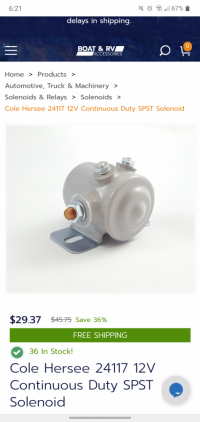You are using an out of date browser. It may not display this or other websites correctly.
You should upgrade or use an alternative browser.
You should upgrade or use an alternative browser.
Does Solenoid for Glow Plugs Make a Difference? [and Troubleshooting Installation]
- Thread starter patrscoe
- Start date
I'm getting around to the solenoid for glow plugs, with Maine Sail's Cole-Hersey device.
MS says "steal power from the starter motor." On my model the starter motor terminals are quite out of reach, I'd have to take the alternator and some hoses off.
So instead I plan to power the solenoid with a three-foot #10 wire direct from the battery bank, fused near the battery end. (20 amp fuse? 30 amp?).
See any issue with that?
MS says "steal power from the starter motor." On my model the starter motor terminals are quite out of reach, I'd have to take the alternator and some hoses off.
So instead I plan to power the solenoid with a three-foot #10 wire direct from the battery bank, fused near the battery end. (20 amp fuse? 30 amp?).
See any issue with that?
The Universal manual says the glow plugs are six amps each, so 30 amps is probably fine for four plugs.See any issue with that?
Nothing "wrong" with your idea, but it creates an always-hot circuit for something that will only be used when the engine control panel is powered. Also, if you lose that battery bank, you can't energize your glow plugs.
Might be better to tap into the red wire that powers the engine panel (this wire originates at the starter lug). If you butt-spliced this red wire back together after removing the trailer plug, you might have to recut it and add ring terminals and a small terminal bar to add the new line to your solenoid. Or, if it's not already fuse protected on the starter end (Ericson often fused this red wire at the engine panel, which can be a hazard), use one of these as your "terminal bar" (https://www.bluesea.com/products/7157/Marine_Grade_Short_Stop_Circuit_Breakers_-_50A) and you'll be adding circuit protection closer to the power source--where it should be.
Wired this way, the circuit is only hot when your battery switch is ON, and, either battery bank (as selected by the BATT switch) can power the solenoid.

Last edited:
Dave G.
1984 E30+ Ludington, MI
That's definitely a better place to pull from. No always hot circuit, works off both batt banks. That is one "perty" engine Ken.Might be better to tap into the red wire that powers the engine panel
JSM
Member III
When I did mine I initially was going to go with a solenoid. After reading this thread I decided to go with a relay. Its been in place for almost a year now and I have had zero problems with it.
Last edited:
Good stuff. Thanks, gents.
Well, that didn't work.
I installed the Cole-Hersey, mounted on the engine block. One end to the glow plugs, the other (temporarily) to the battery bank. Cockpit glow plug switch wire goes to one of the small poles.
When I push the glow plug button, nothing happens. No voltage drop on the voltmeter. No heating of the plugs.
I tried the cockpit panel glow plug button wire on each of the small poles. No dice. A hot wire direct from battery applied to either of them creates no click.
I figure the ground is good--one bolt only, but right on the engine. I wonder if, as another member found, the new solenoid is no good. Seems unlikely, however one of the small posts wobbles loose to the touch.
[Update: I figured wrong. The CH doesn't use the base as a ground, it uses one of the small poles. More at Post #42]
 ...
...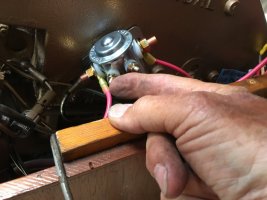
I installed the Cole-Hersey, mounted on the engine block. One end to the glow plugs, the other (temporarily) to the battery bank. Cockpit glow plug switch wire goes to one of the small poles.
When I push the glow plug button, nothing happens. No voltage drop on the voltmeter. No heating of the plugs.
I tried the cockpit panel glow plug button wire on each of the small poles. No dice. A hot wire direct from battery applied to either of them creates no click.
I figure the ground is good--one bolt only, but right on the engine. I wonder if, as another member found, the new solenoid is no good. Seems unlikely, however one of the small posts wobbles loose to the touch.
[Update: I figured wrong. The CH doesn't use the base as a ground, it uses one of the small poles. More at Post #42]
 ...
...
Last edited:
Rocinante33
Contributing Partner
Your exhaust manifold, where you have the relay/solenoid bolted appears to be beautifully painted, so I still suspect the ground is poor. Try a simple jumper wire with alligator clips an clip to the body of the relay and to the back of the bolt which I see for securing the alternator belt tension. That may be a better ground connection. Otherwise you may need to scrape the paint off the spot where you bolt that thing.Well, that didn't work.
I installed the Cole-Hersey, mounted on the engine block. One end to the glow plugs, the other (temporarily) to the battery bank. Cockpit glow plug switch wire goes to one of the small poles.
When I push the glow plug button, nothing happens. No voltage drop on the voltmeter. No heating of the plugs.
I tried the cockpit panel glow plug button wire on each of the small poles. No dice. A hot wire direct from battery applied to either of them creates no click.
I figure the ground is good--one bolt only, but right on the engine. I wonder if, as another member found, the new solenoid is no good. Seems unlikely, however one of the small posts wobbles loose to the touch.
View attachment 38981...View attachment 38982
I recall having a similar issue, despite sanding some paint off the unused heat exchanger bracket I attached it to. I had to run a wire from the solenoid body to the negative ground bus which solved the problem. Looks like I used a cable lug as a washer for some reason that I don't remember.
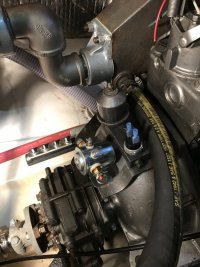



Last edited:
I'll work on the ground.
Ken,
I notice that you have two wires to the terminals. One is a switch and the other is? I have the same solenoid, mounting it on the heat exchanger as a ground, connecting the power feed from the starter which is about 6" away from this and the connecting the glow plugs on the other side. But not sure what the extra terminal is used for next to the switch stud.
I notice that you have two wires to the terminals. One is a switch and the other is? I have the same solenoid, mounting it on the heat exchanger as a ground, connecting the power feed from the starter which is about 6" away from this and the connecting the glow plugs on the other side. But not sure what the extra terminal is used for next to the switch stud.
Patrick, Christian,
There must be two different switch configurations. On mine, the two smaller posts are not "S" and "I" posts as in a Ford type start/ignition relay.
Mine is an "insulated ground" relay so one of the small posts (it doesn't matter which) is the ground of the magnetic coil. It is not grounded through the casing. Mine is mounted to the wood frame above the engine.
A MFG note also says to mount upside-down, though most people don't.
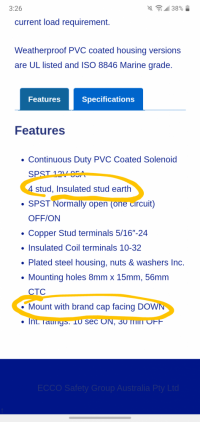
 colehersee.com.au
colehersee.com.au
There must be two different switch configurations. On mine, the two smaller posts are not "S" and "I" posts as in a Ford type start/ignition relay.
Mine is an "insulated ground" relay so one of the small posts (it doesn't matter which) is the ground of the magnetic coil. It is not grounded through the casing. Mine is mounted to the wood frame above the engine.
A MFG note also says to mount upside-down, though most people don't.

SPST 12V 85A Continuous Duty Solenoid – Cole Hersee
Last edited:
Similar with Christian, I installed the solenoid and did not work so I had a bypass set up to go back to the original set up until I had time to figure it out.
I purchased the same CH solenoid that you have except that it is not the waterproof version. I installed my directly to the heat exchanger, which I have a grounding to the same bolt that is attached to the bracket for another system so I knew the ground was good but if the bracket is not set up like that, it was never grounded.
I was using someone's guide from the Catalina site which had a M25 but he must of had a different solenoid but looked the same.
thanks
I purchased the same CH solenoid that you have except that it is not the waterproof version. I installed my directly to the heat exchanger, which I have a grounding to the same bolt that is attached to the bracket for another system so I knew the ground was good but if the bracket is not set up like that, it was never grounded.
I was using someone's guide from the Catalina site which had a M25 but he must of had a different solenoid but looked the same.
thanks
I put the Cole Hersey aside* and replaced it with a Ford type. To eliminate grounding issues, I ran a wire from the base to the negative house bank and remounted it off the engine (which looked clumsy). Now the solenoid clicks (loudly) when the mom-on button in the cockpit is pushed.
But shouldn't the first glow plug get hot to the touch after a 20 second button-push?
I get voltage drop on the voltmeter of about 1 volt. Formerly it was more like a 2-volt drop.
I'll try a cold start with 10 seconds glow tomorrow, but I have doubts.
(*I think I may have fried it with my sparky tests)
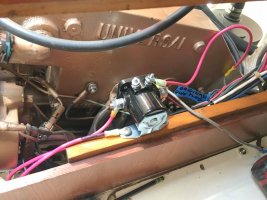
But shouldn't the first glow plug get hot to the touch after a 20 second button-push?
I get voltage drop on the voltmeter of about 1 volt. Formerly it was more like a 2-volt drop.
I'll try a cold start with 10 seconds glow tomorrow, but I have doubts.
(*I think I may have fried it with my sparky tests)

But shouldn't the first glow plug get hot to the touch after a 20 second button-push?
I get voltage drop on the voltmeter of about 1 volt. Formerly it was more like a 2-volt drop.
The cylinder end of the plug should get hot, but not the external "wired" end. The metal around the cylinder would absorb the heat long before you feel it on the wired end (unless you removed the plug when you did your test).
I think you'll be ok.
Seems I remember something in the Cole-Hersee instructions about not loosening the internal nut on any of the terminals for risk of damaging the internal connections. That loose terminal you had would be grounds enough for me for request a refund.
Parrothead
Member III
Back to basics
The advantage of the solenoid or relay in the glow plug circuit is to reduce the load carrying circuit length with the original undersized wiring to reduce voltage drop. It's not without disadvantages though such as an added component (relay/solenoid), multiple additional connections (each one a potential failure point) and added complexity.
The same goal can be achieved without the disadvantages by increasing the glow plug circuit wire size following any of the voltage drop calculators available online. Make the target voltage drop under 3% and you'll be golden.
The advantage of the solenoid or relay in the glow plug circuit is to reduce the load carrying circuit length with the original undersized wiring to reduce voltage drop. It's not without disadvantages though such as an added component (relay/solenoid), multiple additional connections (each one a potential failure point) and added complexity.
The same goal can be achieved without the disadvantages by increasing the glow plug circuit wire size following any of the voltage drop calculators available online. Make the target voltage drop under 3% and you'll be golden.
Success after I re-wired the grounding. The second stud on top of the CH solenoid is used for the ground, exactly what Ken stated.
Everyone was correct and I notice a difference immediately.
Before - Cold start at about 50 to 60 degrees; would take me 10 sec of glow plug time, attempt to start and another 10 sec of glow plug, after that starting would sputter for about a second before actually starting. I replaced the glow plugs last fall and I typically try not to have more than 15 sec at a time.
Now - With the solenoid; about 5 sec of glow plug, started immediately and with no sputtering. It was a little warmer this morning but it still would have been 10 sec glow plug time and maybe another 5 sec after that.
After this, I notice that my voltage did not drop and my fuel pump did not slow down while I push the glow plug button. Just to make sure the starting time was not a fluke, I pulled two of the three glow plugs and tested them and they are working fine.
I wonder why this happen.
Anyways, I also cleaned the terminals at the starter solenoid and other power and grounding terminals, and it appears to stop the once in a while 'push the starter button and nothing happens for about 2 pushes.
Everyone was correct and I notice a difference immediately.
Before - Cold start at about 50 to 60 degrees; would take me 10 sec of glow plug time, attempt to start and another 10 sec of glow plug, after that starting would sputter for about a second before actually starting. I replaced the glow plugs last fall and I typically try not to have more than 15 sec at a time.
Now - With the solenoid; about 5 sec of glow plug, started immediately and with no sputtering. It was a little warmer this morning but it still would have been 10 sec glow plug time and maybe another 5 sec after that.
After this, I notice that my voltage did not drop and my fuel pump did not slow down while I push the glow plug button. Just to make sure the starting time was not a fluke, I pulled two of the three glow plugs and tested them and they are working fine.
I wonder why this happen.
Anyways, I also cleaned the terminals at the starter solenoid and other power and grounding terminals, and it appears to stop the once in a while 'push the starter button and nothing happens for about 2 pushes.
MaineSail's "Marine How To" site still shows the Ford-type solenoid where power is thru the S terminal and ground is "common" through the case. Probably where some of the confusion comes from.
Most of the Cole Hersee solenoids seem to be "insulated" grounds now.
Most of the Cole Hersee solenoids seem to be "insulated" grounds now.

